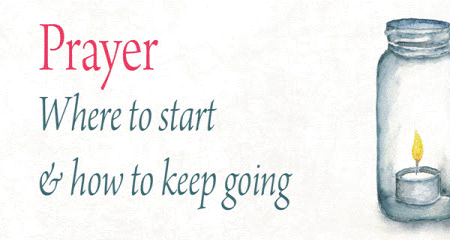


PART SIX
What is prayer and
how do I start?
Do I need words to pray?
'Like so many things in life,
so with prayer,
going deeper often means less,
not more.
Here are some ways of simplifying
and purifying your prayer each day.'
The simplest prayer of all
is just saying the name of Jesus.
"All who call on the name of the Lord
will be saved," says St Paul
(Romans 10.3).
The name Jesus means "God saves".
As we say his name,
so we invite Jesus to be with us.
The Jesus Prayer
This way of praying is known
as the Jesus prayer.
It is very popular in the Orthodox
tradition of the church.
There are various wordings,
all roughly the same.
One of the most common is:
Lord Jesus Christ,
Son of the living God,
have mercy on me,
a sinner.
It's based on the cry of the repentant
tax collector in Jesus' parable:
"God, be merciful to me,
a sinner" (Luke 18.13).
But it also echoes St Paul's great
hymn of praise in Philippians:
Jesus is the Son of God
but empties himself to take
the form of a servant
(Philippians 2.6-11)
Try saying the prayer over and over again.
Breathe in on the first two phrases -
Lord Jesus Christ,
Son of the living God.
And breathe out on the third -
have mercy on me a sinner.
As you do so,
breathe in the righteousness
and peace of God,
and cast out all those things
that separate us from God.
It is a prayer that is to be said slowly.
It is meant to be said many times over.
It is one of the simplest ways of praying.
It can be prayed by anyone, anywhere.
If you find yourself sometimes waiting
in the dark of the night
and gripped by fear or anxiety,
it is a wonderful way
of calming the spirit.
This kind of prayer is also a
good way of praying when we are
feeling tired or distracted,
or where we just don't
know what to say.
Holding cross
And if even saying
the name of Jesus becomes impossible -
in the loneliness of isolation,
anxiety or illness -
another way of praying is to
hold on to the cross of Christ.
I always carry a holding cross
in my pocket.
I often find myself clutching it
and receiving comfort.
It is a tangible reminder of
the cross of Christ through which
I have been brought into
relationship with God.
When my father was dying,
I gave him a holding cross.
When he was no longer able
to speak to me,
he held onto the cross.
When he died
the cross was in his hand.
Silence
Then there is that prayer
which has no words at all.
"Be still and know that I am God,"
says the psalmist (Psalm 46.10).
The prayer which is stillness
and silence is about waiting on
God and letting God be God.
The awesome majesty of God
stops us in our tracks;
silences the frantic jabber of our minds;
and brings us to our knees.
This kind of silence is not emptiness:
it is heavy with the mighty presence of God.
In all our prayers,
and however we find prayer working for us,
there should always be this silence
and this waiting upon God.
Paradoxically,
some of us find interior silence easier
when we are moving.
But this walk could be a prayer walk.
We walk and reflect.
We walk and we pray for others.
If you don't find silence easy,
then begin with just a few moments.
But as you grow in prayer,
so you will also find that you grow in
an ability to find this interior stillness.
The Lord's Prayer
Finally, the heart and foundation
of all Christian prayer is the Lord's Prayer.
If we do nothing else,
we should try to recite this prayer
at least once every day.
It is to this prayer,
and what it can teach us about
the whole of prayer,
that we will turn next.
"Be still, then,
and know that I am God."
Psalm 46.11
Are there any other prayers you know by heart?
You could try keeping a notebook
of new prayers you discover.
The next time you're in a quiet place,
listen to the silence...
Prayer
Our Father in heaven,
hallowed be your name,
your kingdom come,
your will be done,
on earth as in heaven.
Give us today our daily bread.
Forgive us our sins
as we forgive those who sin against us.
Lead us not into temptation
but deliver us from evil.
For the kingdom, the power,
and the glory are yours
now and for ever
Amen.
(The Lord.s Prayer in contemporary language)
The material by Stephen Cottrell is taken from
the illustrated Church House Publishing book
and eBook Prayer:
Where to Start and How to Keep Going.
The text is © Stephen Cottrell 2020
and includes material adapted from How to Pray,
which is © Stephen Cottrell 1998, 2003, 2010
and is used here with permission of
the author and publishers.
Prayers from Common Worship volumes
and New Patterns for Worship are
copyright ©The Archbishops' Council
2000-2008 and 2002 respectively and are
published by Church House Publishing.
Used here with permission.
All rights reserved.
Scripture quotations are from the
New Revised Standard Version of the Bible,
Anglicized Edition, copyright © 1989, 1995
by the Division of Christian Education
of the National Council of
the Churches of Christ in the USA.
Used by permission. All rights reserved.
Illustrations are by www.penguinboy.net
Copyright ©2021. The Church of England. All rights reserved.